简介
有限状态机是unity游戏开发中经常用到的一个概念,能制作敌人AI,玩家控制器等。
有限状态机允许对象在内部状态发生改变时改变它的行为,对象看起来好像修改了它的类
实现:将一个个具体的状态类抽象出来
经典案例:玩家行动器
案例中玩家行动包括:待机、移动、跳跃、冲刺、爬墙等
而这么多状态我们再进一步将其分为:
【在墙上的状态】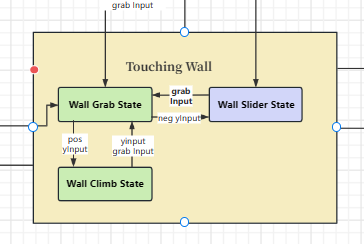
【在地面的状态】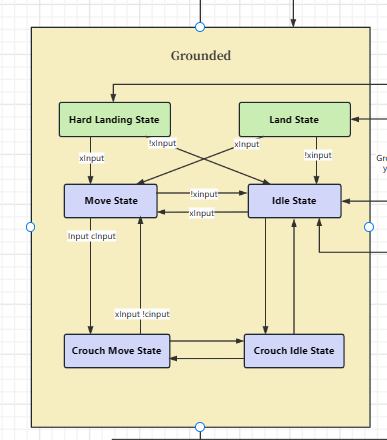
【玩家能力状态】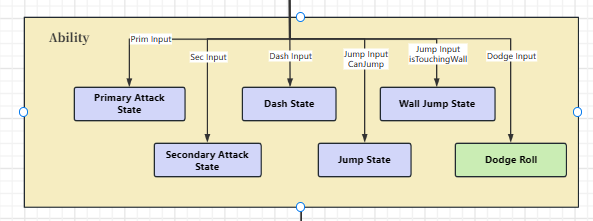
比较特殊的是玩家在空中的状态,我们需要做很多判断,所以不将其抽象,同样的还有冲刺状态。
前期准备
新的输入系统(Input System)
在开始制作状态机前,我们需要将输入系统也更新一下:在包管理器中找到Input System 然后引入
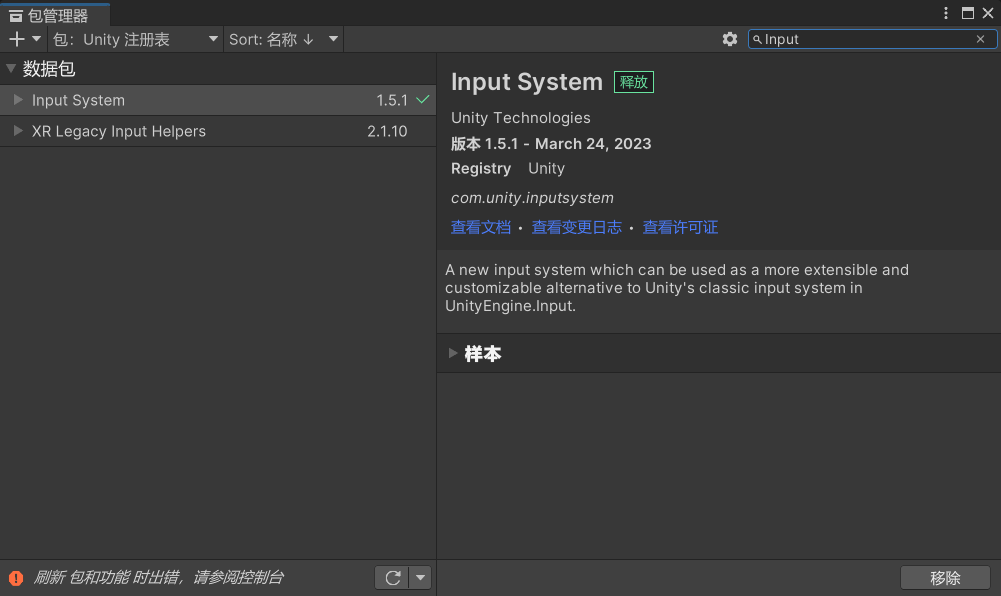
然后在创建中找到 Input Actions 将其命名为Player

双击进入编辑窗口
设置Movement的输入

录入键盘时点击Listen然后再按你想监听的键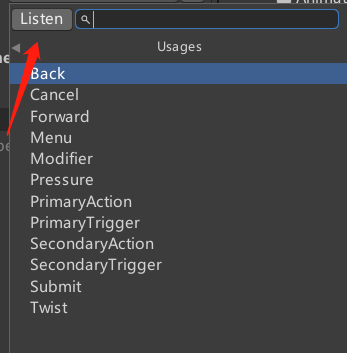
记得设置你的方向
然后在玩家对象上创建Player Input组件,将刚刚创建好的Input System文件挂载上去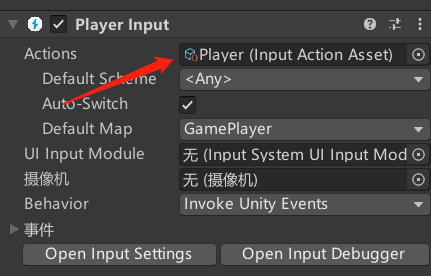
创建C# 脚本 PlayerInputManage
public class PlayerInputManage : MonoBehaviour
{
//新输入系统文件
private PlayerInput playerInput;
//初始移动输入
public Vector2 RawMovementInput { get; private set; }
//X:横轴输入值 Y:纵轴输入值
public int NormInputX { get; private set; }
public int NormInputY { get; private set; }
private void Start()
{
playerInput = GetComponent<PlayerInput>();
}
public void OnMoveInput(InputAction.CallbackContext context)
{
RawMovementInput = context.ReadValue<Vector2>();
NormInputX = Mathf.Abs(RawMovementInput.x) > 0.5f ? (int)(RawMovementInput * Vector2.right).normalized.x : 0;
NormInputY = Mathf.Abs(RawMovementInput.y) > 0.5f ? (int)(RawMovementInput * Vector2.up).normalized.y : 0;
}
}
创建好后回到我们的Player Input文件,点开GamePlayer
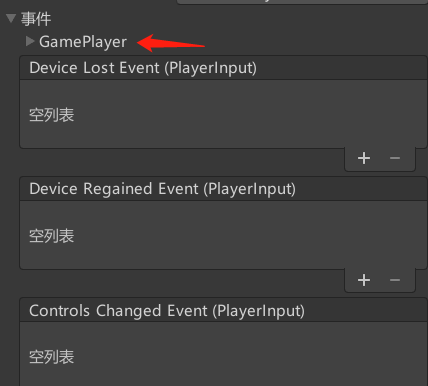
将Player脚本挂载上去
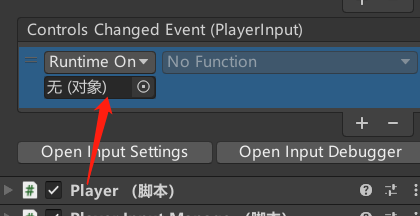
然后在PlayerInputManage中找到刚刚写好的OnMoveInput方法

玩家数据设计
[CreateAssetMenu(fileName ="newPlayerData",menuName ="Data/Player Data/Base Data")]
public class PlayerData : ScriptableObject
{
[Header("移动相关")]//移动速度
public float movementVelocity = 10f;
}
创建完PlayerData脚本后,我们右键 -> 数据 ->

玩家状态设计
public class PlayerState
{
protected Player player;
protected PlayerStateMachine stateMachine;
protected PlayerData playerData;
protected float startTime;//通用计时器
protected bool isAnimtionFinished;//动画是否完成
protected bool isExitingState;//是否已经切换完状态
private string animBoolName;//动画器条件切换
//初始化
public PlayerState(Player player, PlayerStateMachine stateMachine, PlayerData playerData,string animBoolName)
{
this.player = player;
this.stateMachine = stateMachine;
this.playerData = playerData;
this.animBoolName = animBoolName;
}
// 状态开始
public virtual void Enter()
{
Dochecks();
player.Anim.SetBool(animBoolName,true);
startTime = Time.time;
Debug.Log(animBoolName);
isAnimtionFinished = false;
isExitingState = false;
}
// 状态结束
public virtual void Exit()
{
player.Anim.SetBool(animBoolName,false);
isExitingState = true;
}
// 逻辑更新
public virtual void LogicUpdate(){ }
// 物理更新
public virtual void PhysicsUpdate() => Dochecks();
// 图层检测
public virtual void Dochecks() { }
// 开始动画触发
public virtual void AnimationTrigger() { }
// 结束动画触发
public virtual void AnimtionFinishTrigger() => isAnimtionFinished = true;
}
玩家实体设计
public class Player : MonoBehaviour
{
//状态变量
public PlayerStateMachine StateMachine{ get; private set;}//状态管理器
public PlayerIdleState IdleState { get; private set; }//待机
public PlayerMoveState MoveState { get; private set; }//移动
//玩家数据
[SerializeField]
private PlayerData playerData;
//组件变量
public Animator Anim { get; private set;}//动画器
public PlayerInputManage InputManage{ get; private set;}//玩家输入管理
pubilc Rigidbody2D RB { get; private set;}//刚体
public Vector2 CurrentVelocity { get; private set; }//当前速度
public int FacingDirection { get; private set; }//面朝方向
private Vector2 workspace;//工作空间
private void Awake()
{
//AWake在Start前执行,且只执行一次。可用来初始化玩家状态控制器,以及玩家状态
StateMachine = new PlayerStateMachine();
IdleState = new PlayerIdleState(this,StateMachine,playerData,"idle");
MoveState = new PlayerMOveState(this,StateMachine,playerData,"move");
}
private void Start()
{
//Start也只执行一次,但在AWake之后。通常是为组件赋值以及执行初始化方法
Anim = GetComponent<Animator>();
InputManage = GetComponent<PlayerInputManage>();
RB = GetComponent<Rigidbody2D>();
FacingDirection = 1;
StateMachine.Initialize(IdleState);
}
private void Update()
{
//在每一帧执行:确定当前速度,执行当前状态的任务方法
CurrentVelocity = RB.velocity;
StateMachine.CurrentState.LogicUpdate();
}
private void FixedUpdate()
{
//在Update后执行但并不是每一帧都执行:常用于物理检测
StateMachine.CurrentState.PhysicsUpdate();
}
}
玩家状态管理类
public class PlayerStateMachine
{
//当前状态
public PlayerState CurrentState { get; private set; }
//初始化状态
public void Initialize(PlayerState startingState)
{
CurrentState = startingState;
CurrentState.Enter();
}
//切换状态
public void ChangesState(PlayerState newState)
{
CurrentState.Exit();
CurrentState = newState;
CurrentState.Enter();
}
}
玩家待机/移动
当准备好 Player(实体类)、PlayerState(状态父类)、PlayerStateMachine(状态管理类)后,就可以开始写第一个状态类来体验有限状态机的魅力。
通过设计书发现还有3个超级类:
Grounded(在地面)、TouchingWall(在墙上)、Ability(玩家能力) 它们继承于玩家状态类。
public class PlayerGroundedState : PlayerState
{
protected int xInput;
protected int yInput;
public PlayerGroundedState(Player player, PlayerStateMachine stateMachine, PlayerData playerData, string animBoolName) : base(player, stateMachine, playerData, animBoolName)
{
}
public override void Dochecks()
{
base.Dochecks();
}
public override void Enter()
{
base.Enter();
}
public override void Exit()
{
base.Exit();
}
public override void LogicUpdate()
{
base.LogicUpdate();
xInput = player.InputManage.NormInputX;
yInput = player.InputManage.NormInputY;
}
public override void PhysicsUpdate()
{
base.PhysicsUpdate();
}
}
因为玩家执行待机以及移动状态时是在地上的,所以需要继承 PlayerGroundedState 这个状态。我们可以先思考一下:在待机状态需要检测什么,以及如何从待机状态切换出去?你可能会想做一个随机的待机动作,也只需要在LogicUpdate中创建随机数,然后根据随机数切换待机动画。
在视觉上我们想要玩家从移动到待机灵敏一点,也就是放开移动,玩家就立马进入待机状态。
回到Player文件中,需要设置一下玩家在X轴上的速度
public class Player : MonoBehaviour
{
//设置X轴的速度
public void SetVelocityX(float velocity)
{
workspace.Set(velocity, CurrentVelocity.y);
RB.velocity = workspace;
CurrentVelocity = workspace;
}
}
这样就可以在待机状态开始时设置玩家在X轴上的速度,你可以注释掉该行代码试一下两者的手感
因为在待机状态我们并不需要做更多物理检测,所以只需要注重逻辑执行就好。
public class PlayerIdleState : PlayerGroundedState
{
public PlayerIdleState(Player player, PlayerStateMachine stateMachine, PlayerData playerData, string animBoolName) : base(player, stateMachine, playerData, animBoolName)
{
}
public override void Dochecks()
{
base.Dochecks();
}
public override void Enter()
{
base.Enter();
//在状态开始时设置玩家的移动速度为0;
player.SetVelocityX(0f);
}
public override void Exit()
{
base.Exit();
}
public override void LogicUpdate()
{
base.LogicUpdate();
if(!isExitingState)
{//没有结束状态
if (xInput != 0)
{//且有X轴上的输入
stateMachine.ChangesState(player.MoveState);
}
else if(yInput == -1)
{//或有Y轴上的向下的输入
//TODO:切换到下蹲状态
}
}
}
public override void PhysicsUpdate()
{
base.PhysicsUpdate();
}
}
接着写玩家的移动状态,由于要写的是2D项目,所以需要检测玩家做左右移动旋转玩家方向,回到Playe实体类中
public class Player : MonoBehaviour
{
/// <summary>
/// 检测是否转向
/// </summary>
/// <param name="xInput">玩家x轴的输入</param>
public void CheckIfShouldFilp(int xInput)
{
if (xInput != 0 && xInput != FacingDirection)
{//当玩家输入时,输入值(1,-1)与当前面朝方向不一致时,执行转向
Filp();
}
}
private void Filp()
{
FacingDirection *= -1;//设置面朝方向
RB.transform.Rotate(0.0f, 180.0f, 0.0f);
}
}
然后继续写MoveState,同样的移动我们是在地面上,所以要继承PlayerGroundedState
public class PlayerMoveState : PlayerGroundedState
{
public PlayerMoveState(Player player, PlayerStateMachine stateMachine, PlayerData playerData, string animBoolName) : base(player, stateMachine, playerData, animBoolName)
{
}
public override void Dochecks()
{
base.Dochecks();
}
public override void Enter()
{
base.Enter();
}
public override void Exit()
{
base.Exit();
}
public override void LogicUpdate()
{
base.LogicUpdate();
player.CheckIfShouldFilp(xInput);
player.SetVelocityX(playerData.movementVelocity * xInput);
if (!isExitingState)
{
if (xInput == 0)
{
stateMachine.ChangesState(player.IdleState);
}
else if (yInput == -1)
{
//TODO:切换到下蹲移动状态
}
}
}
public override void PhysicsUpdate()
{
base.PhysicsUpdate();
}
}
做完这些就可以在动画器中创建idle、move的动画了
除了xVelocity、yVelocity是单独设置,其他的均为Bool在角色进入状态时执行,可以查看上面 PlayerStateMachine 中的代码

动画退出条件为animBoolName == false ,退出时间与过度时间为0是为了让状态动画间的切换更加丝滑
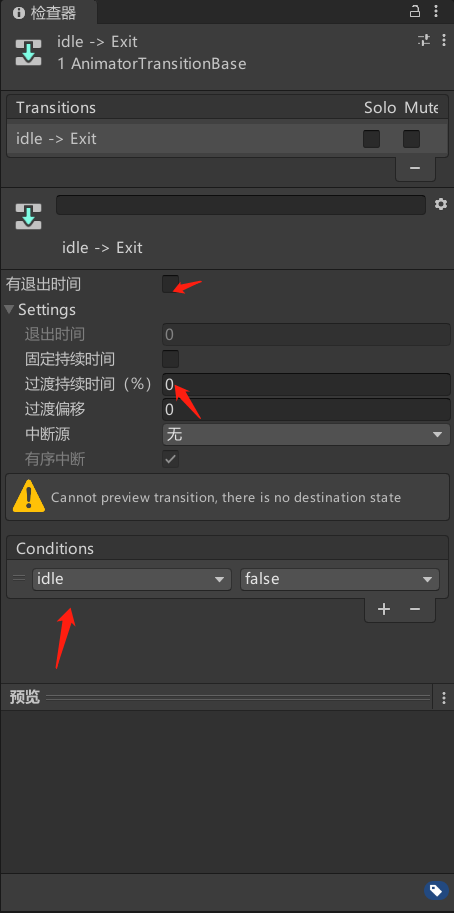
玩家下蹲
通过查看状态机设计图:下蹲状态又分为下蹲时移动,下蹲时待机,它们与玩家的待机和移动状态可以互相切换
首先玩家下蹲,需要控制它的碰撞体与他的图片相等,可以在动画中更改,但那样并不好用。还可以在代码中控制
PlayerData 脚本中定义下蹲后的碰撞器大小,这个根据自己的图片大小决定
public class PlayerData:ScriptableObject
{
[Header("蹲下相关")]
public float crouchMovementVelocity = 5f; //下蹲速度
public float crouchColliderHeight = 0.125f; //下蹲时碰撞器高度
public float standColliderHeight = 0.25f; //站立时碰撞器高度
}
Player 实体类中定义改变碰撞体大小的方法,以及设置所有速度为0的方法,然后还要有一个头顶检测,防止玩家在下蹲进入狭窄空间时松开下蹲键后起立。
public class Player
{
public PlayerCrouchIdleState CrouchIdleState { get; private set; }
public PlayerCrouchMoveState CrouchMoveState { get; private set; }
private void Awake()
{
CrouchIdleState = new PlayerCrouchIdleState(this,StateMachine,playerData,"crouchIdle");
CrouchMoveState = new PlayerCrouchMoveState(this,StateMachine,playerData,"crouchMove");
}
//移动时碰撞器
public BoxCollider2D MovementCollider { get; private set; }
private void Start()
{
MovementCollider = GetComponent<BoxCollider2D>();
}
public void SetVelocityZero()
{
RB.velocity = Vector2.zero;
CurrentVelocity = Vector2.zero;
}
public void SetColliderHeight(float height)
{
Vector2 center = MovementCollider.offset;
workspace.Set(MovementCollider.size.x,height);
center.y += (height - MovementCollider.size.y) / 2;
MovementCollider.size = workspace;//设置碰撞器大小
MovementCollider.offset = center;//设置碰撞器偏移量
}
//检测头顶是否有天花板
public bool CheckForCeiling()
{
return Physics2D.OverlapCircle(ceilingCheck.position, playerData.groundCheckRadius, playerData.whatIsGround);
}
}
别忘了在PlayerGroundedState中调用检测代码
public class PlayerGroundedState
{
protected bool isTouchingCeiling;
public override void Dochecks()
{
base.Dochecks();
isTouchingCeiling = player.CheckForCeiling();
}
}
然后开始写下蹲状态,还是先继承PlayerGroundedState
public class PlayerCrouchIdleState : PlayerGroundedState
{
public PlayerCrouchIdleState(Player player, PlayerStateMachine stateMachine, PlayerData playerData, string animBoolName) : base(player, stateMachine, playerData, animBoolName)
{
}
//开始时设置速度为0,设置碰撞体大小为下蹲后的碰撞体大小
public override void Enter()
{
base.Enter();
player.SetVelocityZero();
player.SetColliderHeight(playerData.crouchColliderHeight);
}
//结束时,设置碰撞器大小为站立后的碰撞器大小
public override void Exit()
{
base.Exit();
player.SetColliderHeight(playerData.standColliderHeight);
}
public override void LogicUpdate()
{
base.LogicUpdate();
if (!isExitingState)
{
if (xInput != 0)
{//如果有X轴的输入,切换到下蹲移动状态
stateMachine.ChangesState(player.CrouchMoveState);
}
else if (yInput != -1 && !isTouchingCeiling)
{//如果没有Y轴的输入,且头顶没有天花板,切换到待机状态
stateMachine.ChangesState(player.IdleState);
}
}
}
}
下蹲移动状态与下蹲状态差不多
public class PlayerCrouchMoveState : PlayerGroundedState
{
public PlayerCrouchMoveState(Player player, PlayerStateMachine stateMachine, PlayerData playerData, string animBoolName) : base(player, stateMachine, playerData, animBoolName)
{
}
//开始时,设置碰撞体大小为下蹲后的碰撞体大小
public override void Enter()
{
base.Enter();
player.SetColliderHeight(playerData.crouchColliderHeight);
}
//结束时,设置碰撞体大小为站立后的碰撞体大小
public override void Exit()
{
base.Exit();
player.SetColliderHeight(playerData.standColliderHeight);
}
//在执行过程中,设置X轴速度为玩家下蹲速度,并判断是否需要转向
public override void LogicUpdate()
{
base.LogicUpdate();
if (!isExitingState)
{
player.SetVelocityX(playerData.crouchMovementVelocity * player.FacingDirection);
player.CheckIfShouldFilp(xInput);
if (xInput == 0)
{ //如果没有X轴输入,切换到下蹲待机状态
stateMachine.ChangesState(player.CrouchIdleState);
}
else if (yInput != -1 && !isTouchingCeiling)
{ //如果没有Y轴输入,且头顶没有天花板,切换到移动状态
stateMachine.ChangesState(player.MoveState);
}
}
}
}
写完这些后,还记得上面的Idle和Move状态中,还有两个切换状态的TODO,现在由你们自己添加上。
玩家跳跃
跳跃永远是2D平台设计的一个难点,也是有限状态机中最多判断条件的状态
跳跃分三个阶段:起跳、在空中、落地
所以需要有三个状态:JumpState,InAirState,LandState
在这之前要先在Player、PlayerInputManage中做些准备
来到Player Input文件中,创建跳跃键的监听。像之前写移动监听一样

在InputManage中,写上OnJump()方法
public class PlayerInputManage : MonoBehaviour
{
//监听Jump输入
public bool JumpInput { get; private set; }
public bool JumpInputStop { get; private set; }
//按下跳跃键的时间
private float jumpInputStartTime;
public void OnJumpInput(InputAction.CallbackContext context)
{
if (context.started)
{
JumpInput = true;
JumpInputStop = false;
jumpInputStartTime = Time.time;
}
if (context.canceled)
{
JumpInputStop = true;
}
}
//实现跳跃完美手感的关键
public void UseJumpInput() => JumpInput = false;
}
这里解释一下:因为按键监听是放在Update()中每帧调用,而跳跃的任务代码是检测的跳跃输入后在FixedUpdate()中在Update()后调用但频率大约为30帧/次。这大概就是你按了跳跃,但是输入值已经判断过了,会出现跳跃判断不及时的情况。
我们要做的就在跳跃状态里手动的将JumpInput判定改为false。然后玩家需要在地面上才能起跳,所以还要检测一下玩家是否在地面
public class Player
{
public PlayerJumpState JumpState { get; private set; }
private void Awake()
{
JumpState = new PlayerJumpState(this, StateMachine, playerData, "inAir");
}
// 检测是否在地面
public bool CheckIfGrounded()
{
return Physics2D.OverlapCircle(groundCheck.position,playerData.groundCheckRadius,playerData.whatIsGround);
}
}
然后给玩家一个跳跃的速度,待会还要做多段跳,所以还有记录玩家可跳跃的次数
public class PlayerData:ScriptableObject
{
[Header("跳跃相关")]
public float jumpVelocity = 15f; //跳跃速度
public int amountOfJumps = 1; //跳跃次数
}
好像还忘了玩家能力这个父类
//何为玩家的能力:比如跳跃、冲刺、攻击等在动画结束就完成一次的就叫玩家的能力
public class PlayerAbilityState : PlayerState
{
//是否完成能力
protected bool isAbilityDone;
private bool isGrounded;
public PlayerAbilityState(Player player, PlayerStateMachine stateMachine, PlayerData playerData, string animBoolName) : base(player, stateMachine, playerData, animBoolName)
{
}
public override void Dochecks()
{
base.Dochecks();
isGrounded = player.CheckIfGrounded();
}
public override void Enter()
{
base.Enter();
isAbilityDone = false;
}
public override void Exit()
{
base.Exit();
}
public override void LogicUpdate()
{
base.LogicUpdate();
if (isAbilityDone)
{
if (isGrounded && player.CurrentVelocity.y < 0.01f)
{
stateMachine.ChangesState(player.IdleState);
}
else
{
stateMachine.ChangesState(player.InAirState);
}
}
}
public override void PhysicsUpdate()
{
base.PhysicsUpdate();
}
}
最后开始写跳跃状态,跳跃状态不属于在地面和墙上的状态,它更像是玩家的一种能力,所以继承PlayerAbilityState类
public class PlayerJumpState : PlayerAbilityState
{
public PlayerJumpState(Player player, PlayerStateMachine stateMachine, PlayerData playerData, string animBoolName) : base(player, stateMachine, playerData, animBoolName)
{}
//1、手动更改JumpInput的值实现完美跳跃
//2、设置玩家纵轴速度
//3、能力完成
//4、在空中状态中设置正在Jump中
public override void Enter()
{
base.Enter();
player.InputManage.UseJumpInput();
player.SetVelocityY(playerData.jumpVelocity);
isAbilityDone = true;
player.InAirState.SetIsJumping();
}
}
这样就完成了的起跳状态,现在完成比较特殊的在空中的状态。通过设计书可以看到,在空中状态有非常非常多的判断。

让我们来一一实现
public class PlayerInAirState:PlayerState
{
//Input
public int xInput;
private bool jumpInput;
private bool jumpInputStop;
//Check
private bool isGrounded
//Other
private bool isJumping;
public PlayerInAirState(Player player, PlayerStateMachine stateMachine, PlayerData playerData, string animBoolName) : base(player, stateMachine, playerData, animBoolName)
{
}
//地面检测
public override void Dochecks()
{
base.Dochecks();
isGrounded = player.CheckIfGrounded();
}
public override void Enter()
{
base.Enter();
}
public override void Exit()
{
base.Exit();
}
//X轴输入赋值,跳跃输入赋值
public override void LogicUpdate()
{
base.LogicUpdate();
xInput = player.InputManage.NormInputX;
jumpInput = player.InputManage.JumpInput;
jumpInputStop = player.InputManage.JumpInputStop;
if (isGrounded && player.CurrentVelocity.y < 0.01f)
{//空中 -> 落地
stateMachine.ChangesState(player.LandState);
}
else
{//空中默认设置
player.CheckIfShouldFilp(xInput);
player.SetVelocityX(playerData.movementVelocity * xInput);
player.Anim.SetFloat("yVelocity",player.CurrentVelocity.y);
player.Anim.SetFloat("xVelocity",Mathf.Abs(player.CurrentVelocity.x));
}
public override void PhysicsUpdate()
{
base.PhysicsUpdate();
}
public void SetIsJumping() => isJumping = true;
}
然后就是最后一个阶段的落地状态,也是比较简单。
public class PlayerLandState : PlayerGroundedState
{
public PlayerLandState(Player player, PlayerStateMachine stateMachine, PlayerData playerData, string animBoolName) : base(player, stateMachine, playerData, animBoolName)
{
}
public override void LogicUpdate()
{
base.LogicUpdate();
if (!isExitingState)
{
if (xInput != 0)
{
stateMachine.ChangesState(player.MoveState);
}
else if (isAnimtionFinished)
{
stateMachine.ChangesState(player.IdleState);
}
}
}
}
到这跳跃行为的三个阶段的状态我们就分别写出来了。接着我们来设置它的动画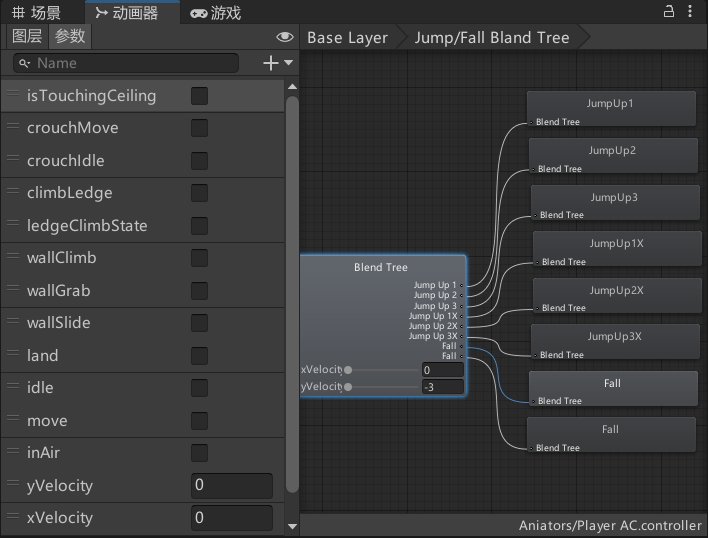
在动画器中右键创建从新混合树,我们需要分别准备:静止状态下的起跳动画JumpUp1、JumpUp2、JumpUp3。以及移动状态下的起跳动画,下落动画,通过下图中的数字组合起来。

子类都设计好了,我们还要在父状态中设计
public class PlayerGroundedState : PlayerState
{
protected int xInput;
protected int yInput;
protected bool isTouchingCeiling;
//键盘输入
private bool JumpInput;
public PlayerGroundedState(Player player, PlayerStateMachine stateMachine, PlayerData playerData, string animBoolName) : base(player, stateMachine, playerData, animBoolName)
{
}
public override void Dochecks()
{
base.Dochecks();
//地面检测
isGrounded = player.CheckIfGrounded();
}
public override void Enter()
{
base.Enter();
}
public override void Exit()
{
base.Exit();
}
public override void LogicUpdate()
{
base.LogicUpdate();
xInput = player.InputManage.NormInputX;
yInput = player.InputManage.NormInputY;
JumpInput = player.InputManage.JumpInput;
if (JumpInput && player.JumpState.CanJump())
{//如果玩家按下跳跃键,并且可以跳跃
stateMachine.ChangesState(player.JumpState);
}
else if(!isGrounded)
{//如果不在地面上
stateMachine.ChangesState(player.InAirState);
}
}
public override void PhysicsUpdate()
{
base.PhysicsUpdate();
}
}
这样有限状态机的跳跃功能就写好了,当然我们的跳跃还有更大的优化空间。如果你觉得当前这样就足够了,可以开始看下一个功能的实现。
跳跃功能优化
很高兴你能打开这一“小段”优化代码,说明你是个为玩家感受着想的游戏开发者。
【二段跳】
早在上面PlayerData中我们预留了一个 amountOfJumps 也就是跳跃次数的变量。现在就可以用这个变量来为角色增加2连跳或者多连跳。
public class PlayerJumpState : PlayerAbilityState
{
private int amountOfJumpsLeft;
public PlayerJumpState(Player player, PlayerStateMachine stateMachine, PlayerData playerData, string animBoolName) : base(player, stateMachine, playerData, animBoolName)
{
amountOfJumpsLeft = playerData.amountOfJumps;
}
public override void Enter()
{
base.Enter();
player.InputManage.UseJumpInput();
player.SetVelocityY(playerData.jumpVelocity);
isAbilityDone = true;
DecreaseAmountOfJumpLeft();//跳跃次数-1
player.InAirState.SetIsJumping();
}
//是否可以跳跃
public bool CanJump()
{
return amountOfJumpsLeft > 0;
}
//重置跳跃次数
public void ResetAmountOfJumpsLeft() => amountOfJumpsLeft = playerData.amountOfJumps;
//减少跳跃次数
public void DecreaseAmountOfJumpLeft() => amountOfJumpsLeft--;
}
因为二段跳或多段跳一般发生在空中,我们来到空中状态
public class PlayerInAirState:PlayerState
{
public override void LogicUpdate()
{
base.LogicUpdate();
xInput = player.InputManage.NormInputX;
jumpInput = player.InputManage.JumpInput;
jumpInputStop = player.InputManage.JumpInputStop;
if (isGrounded && player.CurrentVelocity.y < 0.01f)
{//空中 -> 落地
stateMachine.ChangesState(player.LandState);
}
else if (jumpInput && player.JumpState.CanJump())
{//空中 -> 跳跃(多段跳)
stateMachine.ChangesState(player.JumpState);
}
else
{//空中默认设置
player.CheckIfShouldFilp(xInput);
player.SetVelocityX(playerData.movementVelocity * xInput);
player.Anim.SetFloat("yVelocity",player.CurrentVelocity.y);
player.Anim.SetFloat("xVelocity",Mathf.Abs(player.CurrentVelocity.x));
}
}
}
【土狼时间】
指的是 人物在地面/平台 边缘即将掉落的时候 仍有机会进行跳跃动作
先在PlayerData中确认土狼时间的时长
[CreateAssetMenu(fileName = "newPlayerData", menuName = "Data/Player Data/Base Data")]
public class PlayerData : ScriptableObject
{
[Header("空中相关")]
public float coyoteTime = 0.2f; //土狼时间
}
然后在PlayerInAirState中确定土狼时间的开始时长
public class PlayerInAirState : PlayerState
{
private bool coyoteTime;
public override void LogicUpdate()
{
CheckCoyoteTime();
xInput = player.InputHandler.NormInputX;
jumpInput = player.InputHandler.JumpInput;
jumpInputStop = player.InputHandler.JumpInputStop;
}
private void CheckCoyoteTime()
{
if(coyoteTime && Time.time > startTime + playerData.coyoteTime)
{
coyoteTime = false;
player.JumpState.DecreaseAmountOfJumpsLeft();
}
}
public void StartCoyoteTime() => coyoteTime = true;
}
最后记得在PlayerGroundState中打开土狼时间计时器
public class PlayerGroundedState : PlayerState
{
public override void LogicUpdate()
{
base.LogicUpdate();
xInput = player.InputManage.NormInputX;
yInput = player.InputManage.NormInputY;
JumpInput = player.InputManage.JumpInput;
if (JumpInput && player.JumpState.CanJump())
{
stateMachine.ChangesState(player.JumpState);
}
else if(!isGrounded)
{//开启土狼时间计时器
player.InAirState.StartCoyoteTime();
stateMachine.ChangesState(player.InAirState);
}
}
}
【长按空格跳的更高】
在PlayerData中
[CreateAssetMenu(fileName = "newPlayerData", menuName = "Data/Player Data/Base Data")]
public class PlayerData : ScriptableObject
{
[Header("空中相关")]
public float variableJumpHeightMultiplier = 0.5f;//可变跳跃高度倍速
}
然后在PlayerInAirState中
public class PlayerInAirState : PlayerState
{
public override void LogicUpdate()
{
base.LogicUpdate();
CheckCoyoteTime();
xInput = player.InputMachine.NormInputX;
jumpInput = player.InputMachine.JumpInput;
jumpInputStop = player.InputMachine.JumpInputStop;
CheckJumpMultiplier();//检测跳跃倍速
if (isGrounded && player.CurrentVelocity.y< 0.01f)
{//空中 -> 落地
stateMachine.ChangesState(player.LandState);
}
else if (jumpInput && player.JumpState.CanJump())
{//空中 -> 跳跃(多段跳)
stateMachine.ChangesState(player.JumpState);
}
else
{//空中默认设置
player.CheckIfShouldFilp(xInput);
player.SetVelocityX(playerData.movementVelocity * xInput);
player.Anim.SetFloat("yVelocity",player.CurrentVelocity.y);
player.Anim.SetFloat("xVelocity",player.CurrentVelocity.x);
}
}
private void CheckJumpMultiplier()
{
if (isJumping)
{//如果当前在空中
if (jumpInputStop)
{//如果空格输入停止
player.SetVelocityY(player.CurrentVelocity.y * playerData.variableJumpHeightMultiplier);
//设置当前Y轴速度为:玩家当前Y轴速度的一半
isJumping = false;
}
else if (player.CurrentVelocity.y <= 0f)
{//如果玩家当前Y轴速度小于等于0,说明玩家已落地
isJumping = false;
}
}
}
}
你可以将该方法注释掉试一下效果
玩家冲刺
爬墙是个稍微复杂点的功能,我们先做简单些的冲刺功能。
首先在Player Input文件中定义好冲刺需要按下哪个键
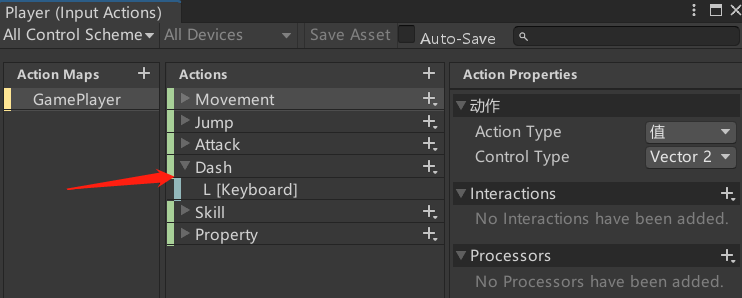
玩家爬墙
文章来源: 博客园
- 还没有人评论,欢迎说说您的想法!





 客服
客服


